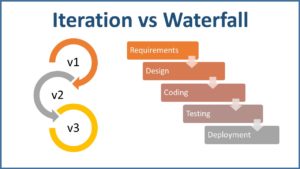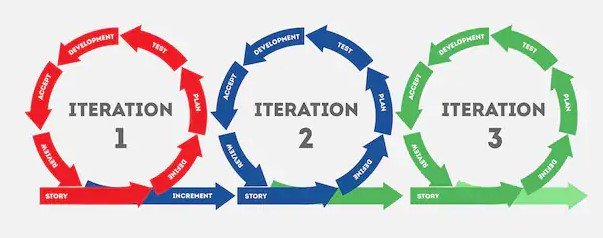Today more and more startups are opting for Agile development to streamline project management and highlight business value.
Agile proposes an iterative approach to software design and development. The methodology involves the constant changes that occur in development. They allow teams to break down lengthy requirements and development stages into smaller parts. Thus, the software is delivered quickly and more frequently.
The iterative model is a part of the software development life cycle (SDLC). This post covers the core process workflow that takes place during an iteration as well as the most vivid pros and cons of the iterative approach. Let’s dive in!
Contents
What is Iterative Development?
Iterative Development means a software development approach aiming to break the dev process into smaller elements. Each part of this breaking is called “iteration” and represents the whole development process, including planning, design, development, and testing phases.
According to the iterative approach, features are added one-by-one, increasing functionality from cycle to cycle (unlike in the Waterfall model). This model is primarily focused on a simplified implementation that gets more complex as it comes toward the final version.

The iterative model is about gradual improvement. It means that developers need to repeatedly go through planning, design, coding, testing and evaluation stages to rework the product or add extra functionality. Frequent releases help to gather feedback and improve the product to meet the requirements.
All Agile software development projects are iterative because they allow for repeating development activities and revisiting the same work products. They are also structured around the iterations of fixed calendar dates.

Iterative development origins
The history of iterative development begins at least a few years before the history of Agile.
- 1984 — the studies of Barry Boehm exploring prototyping (an iterative strategy by essence) show that the iterative model first started receiving attention around that time. It was probably driven by the rise of personal computers.
- 1986 — the “Spiral model of software development and enhancement” was presented in an article by Barry Boehm. The model was aimed to define and decrease the risks through any appropriate approaches.
- 1995 — the article “Growth of human factors in application development“ by Alistair Cockburn was published. It covered the key reasons why the iterative model is gradually gaining popularity.

The Essence of the Iterative Model
As we’ve mentioned above, the traditional Waterfall model is focused more on the strict step-by-step development stage’ process. The iterative model contains cyclical processes.
At first, you plan. Then a small set of stages is repeated over and over. All enhancements within the model can be quickly recognized and implemented throughout every iteration that lets the next iteration to be better than the previous one.
Stage 1. Planning
All projects in any software development company start with the initial planning. At this stage, specification documents are mapped out, required software or hardware requirements are established, and all preparations for the upcoming stages are discussed.
Stage 2. Analysis and designing
After the planning phase, the team performs an analysis to choose the proper business logic, database models, and so on. Next, the design stage comes, and the team establishes tech requirements.
Stage 3. Implementation
This stage is about the actual implementation and coding processes. All specifications and design docs should be accurately created by this phase.
Stage 4. Testing
Developers go through a range of testing procedures to identify any potential bugs or challenges that have appeared.
Stage 5. Evaluation
This is a time for a thorough evaluation of development. It means that the software development team and customers require examining where the project is and where it must be at the moment.
Why is the iterative model beneficial?
- The iterative approach represents creating the product step by step. It allows teams to identify and correct possible defects during the early stages.
- You get user feedback at the end of each stage. For example, how people see the product at the current moment and what they are expecting it to look like at the final stage. It gives you a chance to perform necessary improvements.
- You save precious time on documentation and focus on project design more.
- You can develop functional prototypes early in the project life cycle.
- You can easily measure progress.
- The project scope changes are less costly and easier to implement.
- The modules are relatively small, that’s why testing seems facilitated.
- You are able to define most risks during the iteration. Higher risks can be considered as a priority.
Are there any pitfalls?
- Despite the flexibility of the process, all the iteration stages are rigid and have to be followed carefully.
- You may face unpredictable changes occurring during iterative development because not all requirements can be specified from the beginning.
- You may face the need to add more resources.
- The need for more intensive project management can be also required.
- It can not always easy to determine the end date for the project conclusion.
- Risk analysis will require a lot of skills, experience, and talent.
Conclusion
Iterative development is often hailed as the perfect solution for young ambitious projects with limited budgets, because the model provides a chance to bring software to the market quickly and gradually make improvements over time.
However, thinking about the iterative approach, you’ll definitely need a highly skilled development team able to protect the project from risks and stalling.





